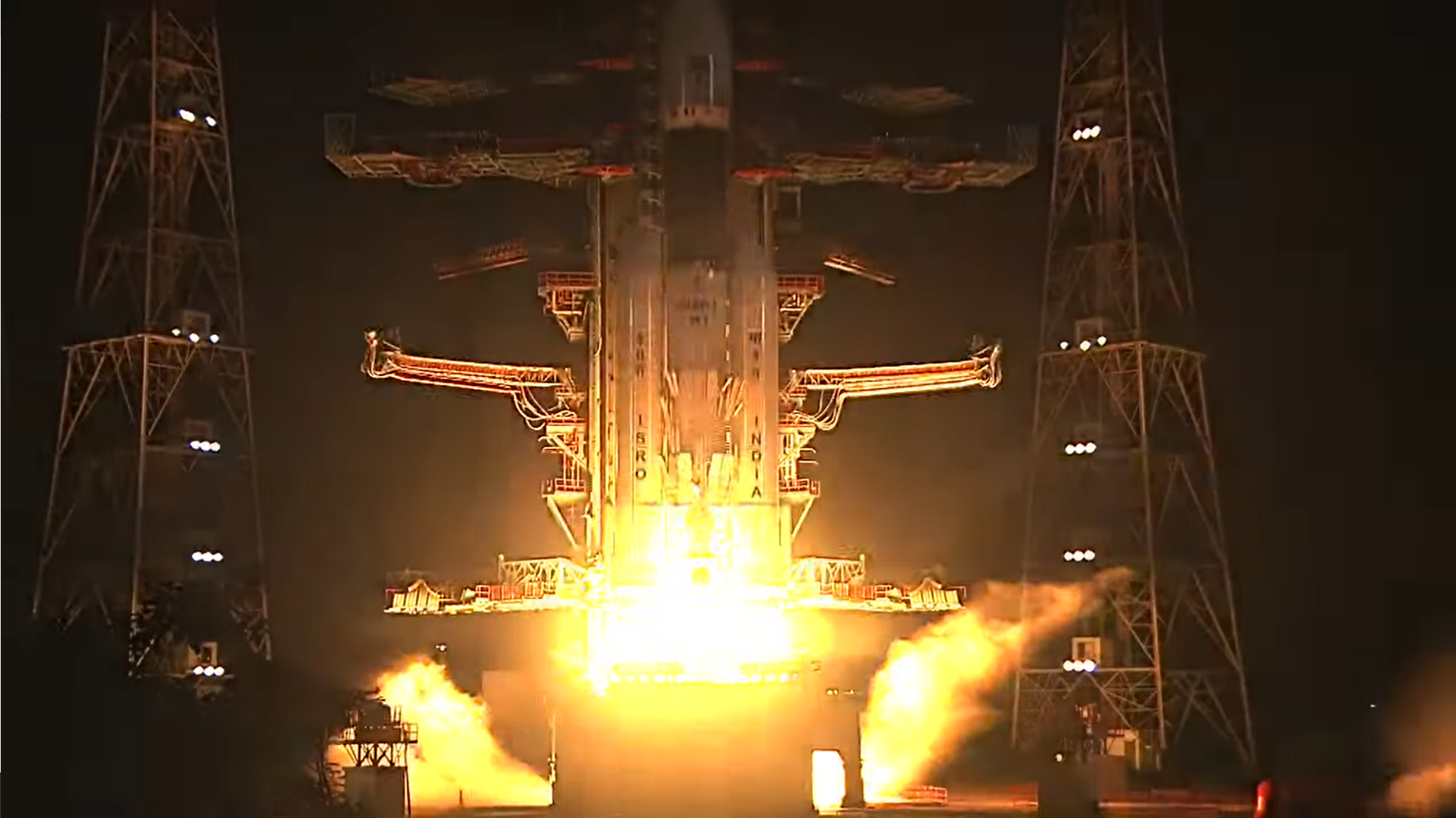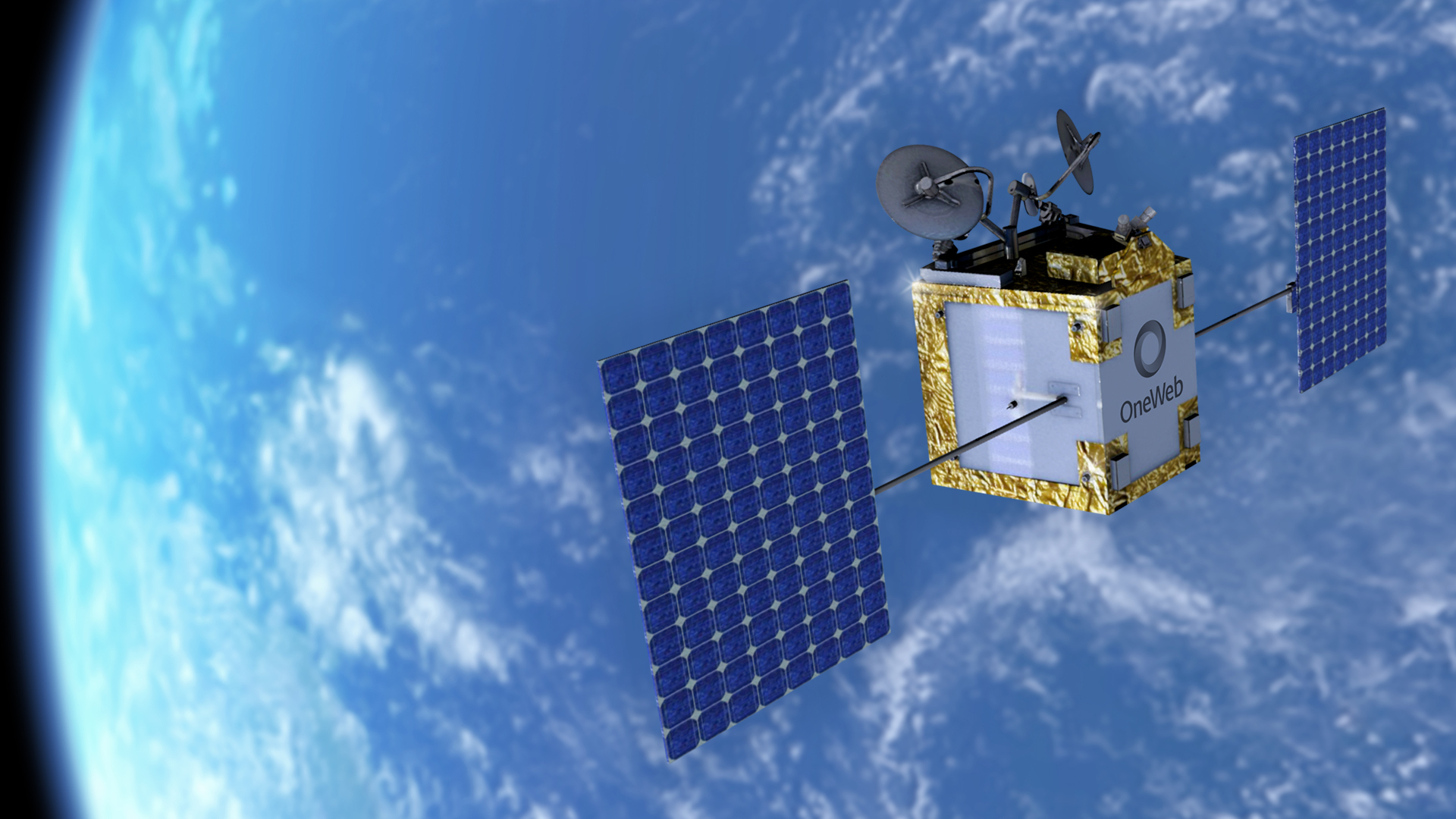OneWeb has begun assembling its satellite-internet constellation again.
Thirty-six of OneWeb's broadband spacecraft took to the skies today (Oct. 22), launching atop a GSLV Mark III rocket, the most powerful rocket in use by the Indian Space Research Organisation, from the Satish Dhawan Space Centre in Sriharikota at 2:37 p.m. EDT (1837 GMT; 12:07 a.m. India Standard Time on Oct. 23).
"Happy Diwali to all of you, so we've started the celebration already," ISRO Chairman S. Somanath said after the successful launch, which coincided the Festival of Lights celebrations in India this weekend. "We have accomplished the orbit very accurately."
The mission was the first for OneWeb since February, when Russia invaded Ukraine and shook up the spaceflight landscape (among many other, more serious impacts). It was the second operational flight of India's GSLV Mark III rocket and the first commercial multi-satellite mission of its kind for the Indian rocket, a flight that was overseen by New Space India Limited (NSIL), ISRO's commercial arm.
Related: OneWeb eyes merger with Eutelsat amid SpaceX Starlink expansion

OneWeb is building out a constellation of 648 broadband satellites. Before today, 426 of those spacecraft had reached orbit, all of them atop Russian-made Soyuz rockets operated by the French company Arianespace. But the ongoing Russian invasion, which began on Feb. 24, splintered that spaceflight partnership, forcing OneWeb to look elsewhere for rocket rides.
The London-based company quickly found some. OneWeb announced in March that it had signed a launch contract with SpaceX, then revealed a month later that it had inked a similar deal with New Space India Limited (NSIL).
Get the Space.com Newsletter
Breaking space news, the latest updates on rocket launches, skywatching events and more!
The terms of these deals — the costs and the number of missions they involve — have not been disclosed.
Today's launch was the first under the NSIL contract, and the GSLV ("Geosynchronous Satellite Launch Vehicle") MkIII apparently performed well in its role as Soyuz stand-in. Less than two hours after launch, all 36 OneWeb satellites had been successfully deployed in their intended orbits.

"All our satellites have successfully separated and now we wait as our team works to confirm contact with all our spacecraft," OneWeb wrote in a Twitter update.
ISRO mission managers appeared filled with pride given the short turnaround between the launch agreement with OneWeb and the launch itself.
"This was a demand given to us by the chairman of ISRO to execute this mission in the very short time of three months," ISRO's mission director Thaddeus Basker V said after the launch. "There was no room for slip and everything has to be done right at the first time, itself."
Basker stressed that the ISRO launch team was diligent in its preparations. "No stone was left unturned and there was no slip," he said. OneWeb's 36-satellite payload weighed more than 6 tons, making it the heaviest payload yet for the GLSV MkIII rocket, Basker said.
The 143-foot-tall (43.5 meters) GSLV MkIII, also known as the LVM3, is the most powerful launcher in India's stable. The three-stage rocket is capable of delivering 17,600 pounds (8,000 kilograms) of payload to low Earth orbit and 8,800 pounds (4,000 kg) to the more distant geostationary transfer orbit, according to its ISRO specifications page.
OneWeb already provides internet coverage to Earth's northern reaches, servicing customers who live above 50 degrees north latitude. That coverage will go global when the full 648-satellite constellation is assembled, a mark that OneWeb plans to hit next year.
"This launch brings OneWeb's constellation to 462 satellites, more than 70% of the satellites required for OneWEb to reach global coverage," the company announced in statement. "This milestone will activate a new phase of OneWeb's launch programme, in pursuit of its mission to bridge the digital divide around the world."
SpaceX is an interesting launch partner for OneWeb, as the two companies are competitors in the satellite-internet field. SpaceX's Starlink megaconstellation — about 3,200 satellites strong and growing all the time — already provides service to customers around the world.
Mike Wall is the author of "Out There" (Grand Central Publishing, 2018; illustrated by Karl Tate), a book about the search for alien life. Follow him on Twitter @michaeldwall. Follow us on Twitter @Spacedotcom or on Facebook.
Join our Space Forums to keep talking space on the latest missions, night sky and more! And if you have a news tip, correction or comment, let us know at: community@space.com.

Michael Wall is a Senior Space Writer with Space.com and joined the team in 2010. He primarily covers exoplanets, spaceflight and military space, but has been known to dabble in the space art beat. His book about the search for alien life, "Out There," was published on Nov. 13, 2018. Before becoming a science writer, Michael worked as a herpetologist and wildlife biologist. He has a Ph.D. in evolutionary biology from the University of Sydney, Australia, a bachelor's degree from the University of Arizona, and a graduate certificate in science writing from the University of California, Santa Cruz. To find out what his latest project is, you can follow Michael on Twitter.









